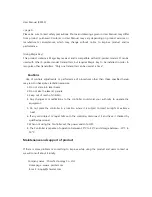
50
C H A P T E R 4
Teach Your Camera New Tricks
DARK FRAME SUBTRACTION AND BAD PIXEL REMOVAL
Do not mistake
Bad Pixel Removal
for
Dark Frame Subtraction
. Both have their
pros and cons:
Dark Frame Subtraction
is a common technique for removing unwanted
artifacts from an image. When an image is taken, the camera will make two
exposures: one with an open lens, the other with a darkened lens. The second
exposure will only show noise and hot pixels. Subtracting the second image
from the first will remove some of these artifacts. Dark frame subtraction is
usually used for long night exposures where the white, hot pixels can be very
disturbing. As a noise reduction technique, it is of limited value; subtracting
noise from noise results in even more noise because noise is a random phe-
nomenon. Therefore, this technique should only be used in combination with
rather low ISO settings. For better noise reduction strategies, see sections
4.3.6 and 4.5.5. With the CHDK, you have the option of switching
Dark Frame
Subtraction
on or off, or of using it only for exposure times longer than one
second
(Auto)
.
Bad Pixel Removal
works quite differently and only in connection with
DNG. A
bad pixel map
is created in advance. In section 4.5.2, we already dis-
cussed how such a map is created. When running, the script
badpixel.lua
grabs a bad pixel map from the camera (normally used for the creation of
JPEG images) and stores it onto the card. The map itself is created when the
camera is manufactured and is part of the firmware. Therefore, and in con-
trast to
Dark Frame Subtraction, Bad Pixel Removal
catches not only hot pixels
but also dark, dead pixels.
Because
Bad Pixel Removal
only replaces single pixels, it does not worsen
the overall signal-to-noise ratio. The catch is that the bad pixel map is static
and doesn’t reflect the fact that bad pixels increase with both exposure time
and the lifetime of the camera.
4.5.3 Other RAW parameters
RAW files saved by the CHDK are not equipped with EXIF data (DNG files
are). This sounds like a drawback because EXIF data are very useful for
processing and archiving images. Vital information such as exposure time,
aperture, ISO speed, focal length, distance, etc., would be missing without
the EXIF data. But because the CHDK always stores both a RAW file and a
JPEG file (which does contain EXIF data), the missing EXIF data in the RAW
file can be easily restored from the JPEG file.
Содержание Camera
Страница 1: ......
Страница 2: ...The Canon Camera Hackers Manual ...
Страница 3: ......
Страница 4: ...Berthold Daum The Canon Camera Hackers Manual Teach Your Camera New Tricks ...
Страница 19: ...10 CH APTER 2 Cameras and Operating Systems ...
Страница 25: ...16 CH APTER 3 ...
Страница 85: ...76 CH APTER 4 Teach Your Camera New Tricks ...
Страница 213: ...204 CH APTER 6 ...
Страница 253: ...244 AP PENDIX ...
















































